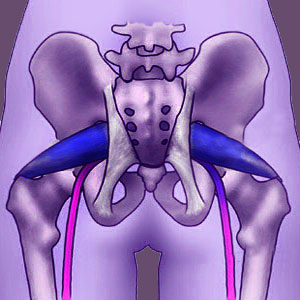
The piriformis muscle is a small, but powerful soft tissue in the deep buttocks anatomy which is responsible for specific hip and leg movements. The piriformis gets its name from the Latin word for “pear shape”, although most doctors tend to describe it as triangular. The piriformis acts as part of a group of muscles called the lateral rotators, which are vital in providing important functionality to our upright posture, especially when ambulating. The muscle seems like an unlikely villain, but it has been blamed for causing many chronic pain conditions through various processes, including injury, muscular imbalances, RSI and of course, the most famous pathology: piriformis syndrome.
This background essay describes the piriformis tissue in vivid detail. We will examine its anatomy, functionality and how the muscle is suspected of creating pain in many patients.
Piriformis Muscle Anatomy
The piriformis tissue attaches to multiple points in the buttocks and pelvis. The muscle attaches to the front of the sacral spine, near the sacroiliac joint, and attaches to the uppermost leg bone, the femur. The muscle occupies space within a region that is often considered problematic among musculoskeletal specialists, including the lower back, sacroiliac joint and hip region.
The path of the muscle places it in direct contact with the sciatic nerve, since it occupies space where the nerve traverses, including the greater sciatic notch and the greater sciatic foramen. In fact, the piriformis actually reduces the effective size of the greater sciatic foramen as it crosses this bodily opening that forms between the joined pelvic ilium and sacrum.
Piriformis Functionality
The piriformis is one of the muscles involved in lateral hip rotation. The other included muscles in this group include the gemellus inferior, gemellus superior, quadratus femoris, obturator externus and obturator internus tissues.
Together these muscles mobilize and stabilize the legs, particularly when walking. They are instrumental in the transference of weight and energy from one side of the anatomy to the other during ambulation. Without full, normal functionality of the lateral hip rotators, the person would have poor balance, an unstable stride and would likely fall due to a lack of integrity in the stability of upright posture as weight is shifted.
Piriformis Muscle Pain Syndromes
The piriformis can suffer injury or repetitive strain, just like any other soft tissue. It can also fall victim to imbalances in antagonistic pairings of muscles that might create hypertensioning or hyperlaxity in the muscle or in other muscles that work together as part of the lateral rotator grouping.
The sciatic nerve is one of the most symptomatic structures in the entire body. Since the piriformis directly interacts with this nerve, it is no surprise that the muscle is often implicated in creating pain that will be expressed in the innervated regions of the lower anatomy which are served by this troublesome nerve. When the piriformis compresses the sciatic nerve, or the pudendal nerve, the condition is diagnosed as piriformis syndrome and will usually produce a range of severe symptoms in the buttocks, legs and possibly, even the feet. Involvement of the pudendal nerve might also produce symptoms in the perineum, groin, genitals and pelvis.
Piriformis Pain > What is Piriformis Syndrome? > Piriformis Muscle




